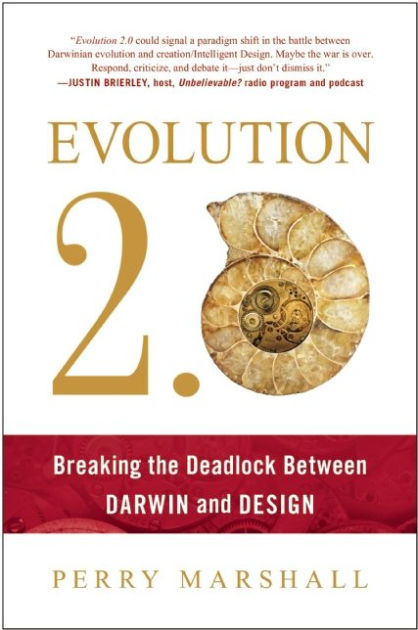|
home | what's new | other sites | contact | about |
|||
|
Word Gems exploring self-realization, sacred personhood, and full humanity
Perry Marshall's an electrical engineer / computer programmer
return to "Evolution" main-page
Editor's note: The following is from Perry Marshall's book, Evolution 2.0: Breaking the Deadlock between Darwin and Design
[Perry relates a story about a friend who began to chat with an old man in a Portland coffee house. The senior happened to be Russell Kirsch, the man who invented the first internally programmable computer, made the first digitized picture.] “How Do You Invent A Computer? “How do you go from conceiving something to reality? How do make the world’s first digitized picture? “Stop and think about what Russell Kirsch has to do to scan the first digital image. He had to decide that 1 means ‘on’ and 0 means ‘off.’ He had to assign 1’s as ‘white’ and 0’s as ‘black.’ He had to choose how many pixels wide the scanner was to be… [etc., etc.] … “Each of these decisions required Kirsch to define many layers of language in detail before a single circuit could be built. “So now the question I needed answered was: How does a cell go from conceiving something to reality? … “Noise is anything that interferes with [an informational[ signal… The Sun is the number one source of radio and TV noise – it generates the hiss you hear between stations… “[In all information systems] noise –defined as random, unwanted disturbance to a wanted signal – is your enemy. “DNA is a code-based communication system. This means DNA battles noise, because all communication channels battle noise. Random DNA copying errors are nothing more than noise. Remember the fruit flies? The DNA copying errors … never seemed to produce anything good. “So I wondered: Are there ever situations where noise can work to your advantage? … I had to study noise. “Claude Shannon’s paper ‘A Mathematical Theory of Communication’ was … written in 1948, made possible our current digital era by pioneering information theory. Scientific American called it ‘the Magna Carta of the Information Age.’ … Since your cell phone, computer [etc.] depend on Shannon’s theory, information theory is one of the most practical mathematical discoveries of the 20th century… “The math that describes the uncertainty of noise is exactly the same as thermodynamic entropy. He called noise ‘information entropy.’ “To most people, entropy is the tendency of [things moving toward disorder]… Heat entropy is the principle in thermodynamics that says that the path from order to disorder is irreversible… “Information entropy is similar, but it applies to data instead of heat… [it] measures the loss of data in a transmitted signal… once data is lost via random mutation, how do you ever get it back, how can we ever know what the original message was “Information entropy is not reversible because once a bit [of information] has been lost and becomes a question mark [in the read-out], it’s impossible to get it back. Worse yet, the decoder doesn’t report the question mark. It assigns it a 1 or a 0 … and you don’t know which bits are the originals and which are only guesses. “Noise equals uncertainty. When there’s no noise and you receive a 1, you are 100% sure that the transmitter sent a 1. “Because signals (encoded messages) and noise are polar opposites, coded information can never come from noise… “I came across [a book] that explained how information theory relates to DNA… by Werner Gitt, ‘In The Beginning Was Information’ … a rigorous treatment of digital data by a skilled engineer… “Gitt … showed that information never comes from noise, elaborating on the work of Shannon. Even more important, Gitt pointed out that all communication systems with digital code that match Shannon’s model and whose origins we know are designed. “There’s a very simple explanation for this. The alphabet (symbols), syntax (grammar), and semantics (meaning) of any communication system must be determined in advance, before any communication can take place. Otherwise, you could never be certain that what the transmitter is saying is the same as what the receiver is hearing. “It’s like when you visit a Russian website and your browser doesn’t have the language plug-in for Russian. The text just appears as a bunch of squares. You would never have any idea if the Russian words were spelled right. “When a message’s meaning is not yet decided, it requires intentional action by conscious agents to reach a consensus… Even if noise might occasionally give you a real word by accident, it could never also tell you what that word means. Every word has to be defined by mutual agreement and used in correct context in order to have meaning. “Random Mutation = Noise “Every communication system battles noise. Noise is a random change of a signal – in other words, noise is a mutation of the original message. In a TV signal, random mutation looks like [a white snow screen]… “Any randomness-based theory of evolution violates the laws of information entropy. Music doesn’t get better when you scratch CD’s; [and] organisms do not gain new features when their DNA mutates through damage or copying errors. Instead they get cystic fibrosis or some other birth defect… Natural selection can clear competition by killing off inferior rivals, but it can’t work backward from random mutation and undo the damage… “Biologist Lynn Margulis, wife of Carl Sagan, was a professor at the University of Massachusetts: ‘Many ways to induce mutations are known [like the radiated fruit flies], but none lead to new organisms. Mutation accumulation does not lead to new species or even to new organs or new tissues… Even professional evolutionary biologists are hard put to find mutations, experimentally induced or spontaneous, that lead in a positive way to evolutionary change’.”
|
|||
|
|
